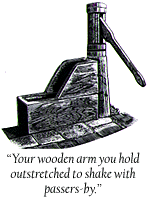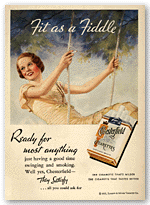
Main Menu ·
Search ·Current
Issue ·Contact ·Archives
·Centennial ·Letters
to the Editor ·FAQs


"Chesterfield, Mrs. Smith?"
Time to own up. "The Fall of the House of Ashes?," a report in
our July-August issue, cited medical historian Allan Brandt's
studies of the tobacco industry's early efforts "to induce more women
to smoke-and to smoke in public." We neglected to tell you that this
magazine-then called the Harvard Alumni Bulletin-had a part in the nefarious
business.
The first national ads to show women smoking broke in the late 1920s. The
Bulletin's complicity began with the issue of January 8, 1932. A full-color
ad on the back cover depicts a pink-cheeked young woman clutching skates
and a pack of Camels. The text states that "women, because their throats
are more delicate than men's, particularly appreciaterelief from the hot
smoke of parched dry-as-dust tobacco, and are switching to Camels everywhere."
 |
A pastoral fantasy of a seductive pastime.
|
Five more Camel ads ran that spring, showing women hikers, a nurse, a black-gloved
traveler on an ocean liner. Liggett & Myers came on board in June with
an ad that portrays "three more Chesterfield smokers"-a blonde,
a brunette, and a redhead, the picture of poise and good health-indulging
on a beachfront patio.
The Bulletin had run cigarette ads before. Small ones for Mogul Egyptian
Cigarettes began appearing in 1903 ("10 for 15 cents. Cork Tips or
Plain. Save the Coupons."). A decade later Liggett & Myers was
placing full-page ads for Fatimas ("No one better knows the good quality
of Fatima than the college fellow-he started its popularity."). But
these were plain old black-and-white ads. The Camel and Chesterfield campaigns
of 1932 took the otherwise monochromatic Bulletin into the brave new world
of four-color advertising. And of lively ladies who lit up in public.
The Camel ads began and ended in 1932. But Chesterfields helped see the
Bulletin through the Depression. The 77 back-cover ads that ran from 1932
to 1939 represent the golden era of Bulletin cigarette advertising.
In 37 of these ads the smokers are exclusively female. Another 27 depict
women and men achieving emotional intimacy with the aid of Chesterfields.
The settings tend to involve outdoor activity, but the men wear coats and
ties and don't look outdoorsy. In only eight of the ads are the smokers
all male. These guys are real men: locomotive engineers, military types,
jackhammer operators.
Some of the ladies are novice smokers. An old-style couple has an exchange
in a horse-drawn carriage. She says, "I thank you-I thank you ever
so much-but I couldn't even think about smoking a cigarette." He says,
"Well, I understand, but they are so mild and taste so good that I
thought you might not mind trying one while we are riding along out here."
We're left to imagine the outcome.
"I really don't know if I should smoke," admits a sincere young
woman in a fur wrap, "but my brothers and my sweetheart smoke, and
it does give me a lot of pleasure. Women began to smoke, so they tell me,
just about the time they began to vote, but that's hardly a reason for women
smoking. I guess I just like to smoke, that's all."
The men who dreamed up these ads-and they had to be men-never ran out of
fantasies. In 1935 a virginal female Santa has cartons of Chesterfields
in her sleigh. Next year Santa's an aviatrix. "The catch of the season"
is a coy angler with fly rod and cigarette. She's really hooked. So are
her sisters who engage in archery, biking, figure skating, fox hunting,
and sledding, cigarettes in hand.
Ocean liners are a favorite venue for romantic couples bound each to each
by codependence on nicotine. Ahead are wedding bells and "a lifetime
of pleasure." A groom in top hat offers his bride a smoke as the limousine
leaves the church: "Chesterfield, Mrs. Smith?" "Yes, thank
you, Mr. Smith."
By 1940, according to estimates by the U.S. Surgeon General's office,
about 25 percent of women smoked, against 16 percent in 1929. How much blame
must the Harvard Alumni Bulletin bear? Its audience was preponderantly male
at the time, so perhaps not very much. In any case it won't happen again.
Years ago the magazine's board of directors banned cigarette advertising
from our pages. They've afforded a smoke-free environment ever since.
~ Primus IV
Main Menu ·
Search ·Current
Issue ·Contact ·Archives
·Centennial ·Letters
to the Editor ·FAQs 


